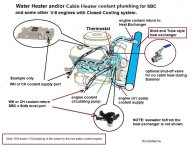The Alpha (if that is what you have for an outdrive), The impeller is more than enough to use for a closed cooling system. It will supply more than enough cold water to an on engine heat exchanger.
But a standard crank driven system will work also. My money is they would flow about the same +/- a few percent volume.
The crankshaft pump would be preferred for the 6.3L build with a closed cooling system.
On the assumption that you do have the A drive, the A drive seawater pump must remain due to upper gear unit cooling.
The A drive seawater can simply be ported overboard.
I would have to look but I believe if you were to plumb the HOT out of the cooling system before it goes through the on engine heat exchanger for a closed cooling system (which would have a 50/50 antifreeze mix), Then to a second heat exchanger at the area you are trying to warm up, That would be the hottest temp fluid. Then the output of the area heat exchanger would go back to the on engine heat exchanger. I dont think it is plausible to only have one heat exchanger as the on engine one will have a raw water supply so extending that raw water supply to the area you want to heat up may not be workable and reduce the heat you want to extract for your area. So having TWO may be needed.
The correct method for plumbing in a cabin heater or water heater, from a Closed Cooling System, is as follows:
coolant supply = the coolant port in the intake manifold just upstream from the thermostat location.
This area is under mild positive pressure.
coolant return = the Stbd most port on the coolant circulating pump..... what many call a "water pump".
This area is under mild negative pressure.
The difference between the mild pressure and mild negative pressure creates balance.
No balance = no coolant flow to/from your Water Heater and/or your Cabin Heater.

I also feel the engine circulating pump has enough to do the job as long as its not probably more that 15-20 feet to area heat exchanger input.
If this is referring to a Cabin Heater, simply increase the ID of the hose.
Doing so will lesson any resistance.
If you use a 160 degree thermostat then your output should be while under load ~170 ish degrees F so it would be similar to a 1960's 180 degree Thermostat heating system in a car, Just enough on most cold days..........
I would not expect sauna like conditions!
If you may want to discuss send me a message with your number
Again, info that can be shared and would potentially benefit all members, is best when kept on the forum.
Why take it off forum, unless there is another agenda?


